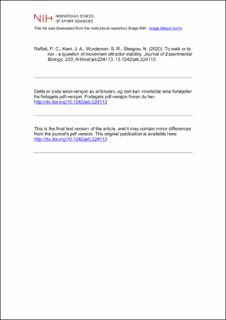To walk or to run - a question of movement attractor stability
| dc.contributor.author | Raffalt, Peter Christian | |
| dc.contributor.author | Kent, Jenny A. | |
| dc.contributor.author | Wurdeman, Shane R. | |
| dc.contributor.author | Stergiou, Nicholas | |
| dc.date.accessioned | 2021-08-04T07:24:39Z | |
| dc.date.available | 2021-08-04T07:24:39Z | |
| dc.date.created | 2020-08-14T14:31:32Z | |
| dc.date.issued | 2020 | |
| dc.identifier.citation | Journal of Experimental Biology. 2020, 223(13), Artikkel jeb224113. | en_US |
| dc.identifier.issn | 0022-0949 | |
| dc.identifier.uri | https://hdl.handle.net/11250/2766089 | |
| dc.description | Dette er siste tekst-versjon av artikkelen, og den kan inneholde små forskjeller fra forlagets pdf-versjon. Forlagets pdf-versjon finner du her: https://doi.org/10.1242/jeb.224113 / This is the final text version of the article, and it may contain minor differences from the journal's pdf version. The original publication is available here: https://doi.org/10.1242/jeb.224113 | en_US |
| dc.description.abstract | During locomotion, humans change gait mode between walking and running as locomotion speed is either increased or decreased. Dynamical systems theory predicts that the self-organization of coordinated motor behaviors dictates the transition from one distinct stable attractor behavior to another distinct attractor behavior (e.g. walk to run or vice versa) as the speed is changed. To evaluate this prediction, the present study investigated the attractor stability of walking and running across a range of speeds evoking both self-selected gait mode and non-self-selected gait mode. Eleven subjects completed treadmill walking for 3 min at 0.89, 1.12, 1.34, 1.56, 1.79, 2.01, 2.24 and 2.46 m s−1 and running for 3 min at 1.79, 2.01, 2.24, 2.46, 2.68, 2.91, 3.13 and 3.35 m s−1 in randomized order while lower limb joint angles and sacrum displacements was recorded. Attractor stability was quantified by continuous relative phase and deviation phase of lower limb segment angles, and the largest Lyapunov exponent, correlation dimension and movement variability of the sacrum marker displacement and the hip, knee and ankle joint angles. Lower limb attractor stability during walking was maximized at speeds close to the self-selected preferred walking speed and increased during running as speed was increased. Furthermore, lower limb attractor stability was highest at a particular gait mode closest to the corresponding preferred speed, in support of the prediction of dynamical systems theory. This was not the case for the sacrum displacement attractor, suggesting that lower limb attractor behavior provides a more appropriate order parameter compared with sacrum displacement. | en_US |
| dc.language.iso | eng | en_US |
| dc.subject | locomotion | en_US |
| dc.subject | dynamical system theory | en_US |
| dc.subject | dynamics | en_US |
| dc.subject | coordination | en_US |
| dc.subject | gait | en_US |
| dc.title | To walk or to run - a question of movement attractor stability | en_US |
| dc.type | Peer reviewed | en_US |
| dc.type | Journal article | en_US |
| dc.description.version | acceptedVersion | en_US |
| dc.source.pagenumber | 10 | en_US |
| dc.source.volume | 223 | en_US |
| dc.source.journal | Journal of Experimental Biology | en_US |
| dc.identifier.doi | 10.1242/jeb.224113 | |
| dc.identifier.cristin | 1823391 | |
| dc.description.localcode | Institutt for fysisk prestasjonsevne / Department of Physical Performance | en_US |
| cristin.ispublished | true | |
| cristin.fulltext | postprint | |
| cristin.qualitycode | 2 |
Tilhørende fil(er)
Denne innførselen finnes i følgende samling(er)
-
Artikler / Articles [2096]
-
Publikasjoner fra Cristin [1084]
